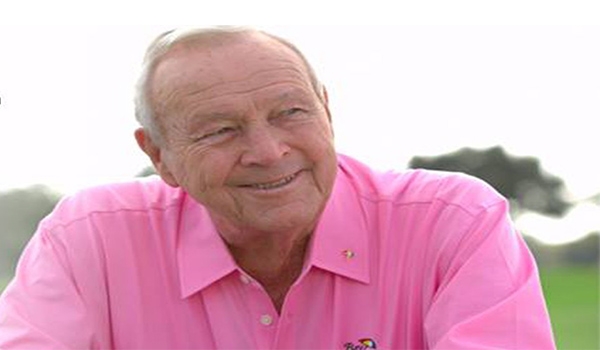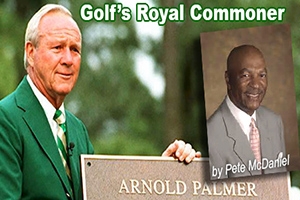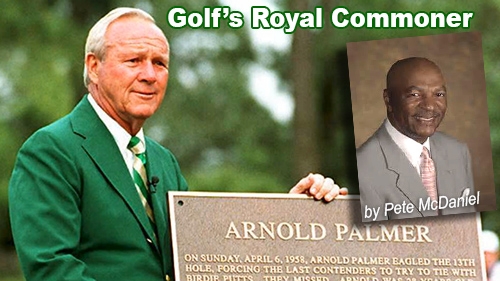Professional golf hitched his pants, sucked on a cigarette without the slightest fear of harming lungs or throat and swaggered down the fairway long before “swag’’ was in vogue or trending. Even in black-and-white the little country boy glued to the boxy Sylvania recognized something different about Arnold Palmer; different from the other club swingers in the televised tournament.
It might have been the U.S. Open or the Masters. Or it could have been Shell’s Wonderful World of Golf episode. I’m not certain. I do remember being mesmerized by that swagger, that wrinkled brow as if it were oven-baked from one of Grandma’s biscuit molds, that lashing pass at the ball as if he were Willie Mays swinging for the fences at Candlestick Park.
Back then I loved baseball, football and basketball, and catching fireflies in a jar. I had a diehard allegiance to Mays and the San Francisco Giants, plus Jim Brown and the Cleveland Browns. I also revered Bill Russell and the Boston Celtics.
The only thing I knew about golf was all the players were starched and pressed white men who left a trail of cigarette smoke behind as they strode the green pastures. With the exception of Arnold Palmer.
Arnie had the flare and daring of Mays and the power of Brown. And he was a crowd-pleaser. The guy had his own army of loyal fans. No one else, not Mays or Brown or Sandy Koufax or Whitey Ford, could match that.
Someone dubbed him “The King,’’ because he ascended to the throne of professional golf. Perhaps it was that aura of royalty I found enticing as a boy getting his first taste of the game, one of exclusivity in this country at the time. I paid scant attention to the fact that all of the men swinging the clubs were white, and most of the men lugging the golf bags were dark-skinned like me.
I wasn’t informed about the game’s dark past until years later when the seasoned caddies at Biltmore Forest CC gave me a history lesson about golfers of color like Charlie Sifford, Brooks Dendy and Ted Rhodes, who were barred from playing on tour because of a skin condition called excessive melanin.
Just like they do today, the TV announcers spoke in hushed tones. Through the crackling of the always poor reception, not remedied by the antenna on the roof of our Jim Walter home, I deciphered that Arnie was not only the fan favorite but the top contender in the event.
Like many folk, I’ve always been drawn to the best player in the competition. Arnie was that player, even in the face of a challenge by a portly young man with blond locks who the commentators were also making a fuss over.
The young guy didn’t smile much, though. Arnie, on the other hand, smiled even when he grimaced, if that’s possible.
They call it charisma. Arnie always had that as a 15th club. If you were a Jack fan, as I grew to be, Arnie would disarm you with a smile and handshake.
And if that didn’t do the trick, his uncanny ability to remember names would.
Years later, while trolling the TV beat for Golf World Magazine, I had my first encounter with Arnie. The Golf Channel was launching its 24-hour coverage of the game, and I had been dispatched to Orlando to record it. I had interviewed Arnie by phone several times, but this was my first face-to-face meeting with the King.
As I prepared to spend the night at the Orlando facility, in walked Arnie and co-owner of the new network, Joe Gibbs, along with several others. Arnie smiled and extended his massive mitt to shake my hand. “Pete, we’re happy to have you here,’’ he said. “Are you being taken care of?’’
I answered in the affirmative and thanked him for asking.
He was always gracious and grateful to be held in such high esteem. It was a 15-minute drive from my Orlando home to Bay Hill, where he lived and hosted his hugely successful PGA Tour event. He was always accessible and accommodating.
There was no one like the King, certainly none of the current crop of megastars, with nowhere near his pedigree, class or resume.
In the interview for the documentary “Uneven Fairways,’’ which I co-wrote and co-produced for Moxie Pictures and Golf Channel, Arnie declared a certain affinity for being around caddies and golf’s unwashed. It was part of his comfort zone. He could identify with them because he was far from the silver spoon set. His roots were a lob wedge from the steel mills in Latrobe, Pa.

Arnie identified with the common man because of those roots and his upbringing. He lived as an exceptional human being with respect for all. He died that way, too. The King was 87 years old.
The image on that TV screen will remain with me forever. Arnie’s unmatched legacy will also endure, for he was a common man with an uncommon touch that popularized the game of golf.
His imprint is on the young dreamer who learned the game beating balls at the country club’s well-manicured practice range, as well as the one emulating his swing in a cow pasture in rural Carolina.
Hitching his pants just like the King.
Pete McDaniel is a veteran golf writer and best-selling author. His blogs and books are available at petemcdaniel.com
Comments on this topic may be emailed directly to Pete at: gdmcd@aol.com




